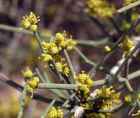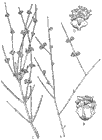Ephedra alata
Decaisne 1834
Common names
Taxonomic notes
There are three recognized subspecies:
- Ephedra alata subsp. alata (syn.: Ephedra altissima Bové 1834);
- Ephedra alata subsp. alenda (Stapf) Trab. 1905 (syn.: Ephedra alenda (Stapf) Andr. 1931); and
- Ephedra alata subsp. monjauzeana Dubuis & Faurel 1957.
Description
Dioecious, much branched, erect, not climbing shrub; branches rigid, yellowish-green, scabrous-glabrous. Leaves very short, united towards base, forming a short sheath. Pollen cones terminal axillary, densely crowded, ovate, 3-8 mm long, with 3-6 long-stipitate or sessile microsporangia on a slightly exerted column. Seed cones pedunculate at nodes, oblong-ovate, up to 10 mm long, with 2 fertile flowers and 4-5 pairs of imbricated, yellowish bracts, with membranous and wavy, wing-like margin. Seeds ovoid, acuminate (Sherif and El-Taife 1986).
See Ephedra aphylla for a key to the four Ephedra species of the Sinai.
Distribution and Ecology
Subsp. alata is native to Algeria, Chad, Iraq, Lebanon, Libya, Mali, Mauritania, Palestine, Saudi Arabia, Sinai, and Syria. Subsp. alenda is native to Africa: Algeria, Egypt, Libya, Mauritania, Morocco, Tunisia, and Western Sahara. Subsp. monjauzeana is native to Algeria only.
Found at elevations of 50-1200 m, E. alata is a xerophytic shrub that typically forms dense clumps in sandy calcareous soil, gravely/rocky soil or clay soil in arid environments, often on locally more mesic sites such as near wadis. Seeds bear wing-like bracts and are dispersed by the wind (Bell and Bachman 2011).
Remarkable Specimens
No data as of 2023.03.03.
Ethnobotany
Observations
See the observations on iNaturalist, accessed 2021.12.29.
Remarks
The epithet means "winged", presumably a reference to the seeds.
Citations
Bell, A. and S. Bachman. 2011. Ephedra alata. The IUCN Red List of Threatened Species 2011. https://www.iucnredlist.org/species/201688/9165505, accessed 2021.12.30.
Decaisne, J. 1834. Annales des Sciences Naturelles, Botanique ser. 2, 2:239. Available: Biodiversity Heritage Library, accessed 2021.12.26.
Sherif, A. S. and A. El-Taife. 1986. Flora of Libya. Al Faateh University Faculty of Science.
See also
Durand, E. A. and J. F. G. Barratte. 1910. Florae Libycae Prodromus, ou, Catalogue raisonné des plantes de Tripolitaine. Genève: Impr. Romet, Froreisen Successeur. 280. Available: HathiTrust, accessed 2021.12.26.
Keith, H. G. 1965. A preliminary check-list of Libyan flora. Tripoli: Ministry of Agriculture and Agrarian Reform. 1:455.
Maire, R. 1952. Flore de l'Afrique Du Nord. Paris: Lechevalier. 1:151.
Species profile at Plants of the World Online, accessed 2021.12.29.


